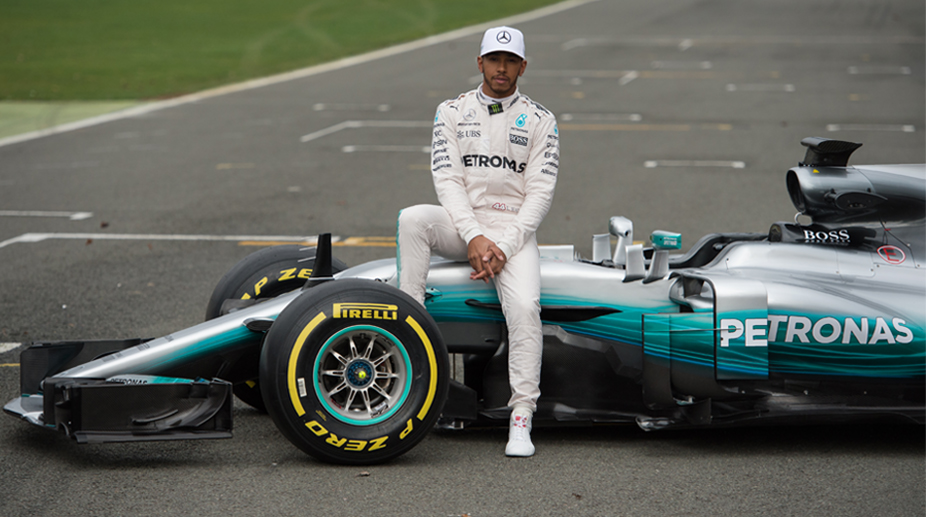Formula 1: Norris ready ‘to take elbows out’ in season 2025
Lando Norris enters the 2025 Formula 1 season with a renewed sense of confidence, determination, and a clear objective—turning last year’s near-miss into a championship triumph.
Know it all before the F1 season begins in Australia this weekend!

Mercedes driver Lewis Hamilton with the W08 car (Photo: AFP)
Formula 1 is arguably the most exhilarating sport there is, full to the brim of technical jargon which can confuse even the most knowledge of fans as the Federation Internationale DE L’Automobile (FIA) introduces new tweaks each season to prevent any form of stagnation setting in.
Some of the finest automobile engineers across the globe spend months working day and night on designs, tweaking them throughout the year to suit their cars and perhaps more importantly, their drivers’ requirements.
So, with the season-opening race, the Australian Grand Prix almost upon us, we take a look at the major changes for the 2017 F1 season in which the cars are likely to be more powerful (and heavier), stiffened by extra downforce and offer extra mechanical grip from broader tyres.
Advertisement
Engine
The much-derided engine token development system has been abandoned, a welcome piece of news for all teams. Manufacturers are now free to put together as many design enhancements during the the season as long as they do not exceed the limit of four engines per driver for the 20 races.
Advertisement
However, weight and materials restrictions have been put in place to limit the scope of their ‘unchecked’ development.
Minimum Weight
The minimum weight limit has been increased from 702 kg (2016) to 722 kg to allow for the cars’ increased proportions.
Bodywork and Aerodynamics
The overall width of the cars has been increased from 1800 mm to 2000 mm, smoothening the path for a new front wing that increases from 1650 mm to 1800 mm (width). The wing also has a suave swept-back shape in plain view and the length of the nose section sees a slight increase.
The overall height of the rear wing has been decreased from 950mm to 950 mm but the width sees a increase from 750 mm to 950 mm. The endplates change from their former rectangular shape to a swept-back one in side elevation, curving innards at their bottom edges.
The side pods now have a 1600m width limit, identical as the floor, which has been increased from 1400.
There is more freedom for the aerodynamicists in the vital bargeboard area immediately ahead of the sidepods, which is crucial to the efficiency of the airflow from the front wing to the rear bodywork encasing the and the diffuser at the rear of the car.
The diffuser’s leading edge now starts 175mm ahead of the rear axle centreline, as opposed to earlier seasons. The dimensions of the diffuser have been altered to help generate more downforce as well, 1050 mm wide and 175mm deep whereas last season it was 1000mm wide and 125 mm deep.
And in an intriguing decision, the FIA has allowed a potential return of the ‘shark fins’, last seen in 2009, on engine covers. Mercedes, Ferrari and Williams were among the big teams that tried those out testing and may just continue with them at Albert Park.
Tyres
Forming an integral chunk of the new package, the tyres from Pirelli are a massive 25 percent wider to improve the mechanical grip as the aerodynamics have been significantly altered.
The front tires increase in width from 245mm to 305mm while the rears increase from 325mm to 405mm, with the overall diameter also increasing.
And last but not the least, Pirelli will continue to supply the regular hard, medium, soft, supersoft and ultrasoft tyres but the individual compounds are different from 2016’s as they aim to make the tyres longer-lasting.
Fuel Limit
Cars can now have 105kg of fuel, an increment of five percent. However, there are restrictions on the fuel blends that teams may use now. They can only nominate five for entire season, with only two permitted over the race weekend.
New Regulations
The rules on clutch engagement have been stiffened significantly, which means starts are more crucial than ever.
There are further limitations on clutch controls, and the movement and location of the paddles as the FIA looks to give more control to the drivers’ instead of the engineers.
Engineers will not be allowed to map settings during clutch engagement, which effectively means drivers will have to figure out on their own on what is the right bite point of the clutch to get the best start without generating too much wheelsman or bringing the engine down.
For wet weather starts, if a safety car is brought out at the beginning of a race, a normal standing start will take place once the track has been deemed fit to race. The safety car will go back to the pit lane and the cars will be line up on the grid for the start.
Advertisement